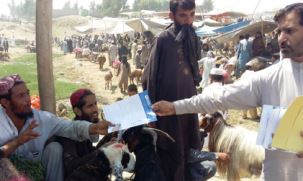 Distribution of information materials on Crimean-Congo haemorrhagic fever (CCHF) at a cattle market in Jalalabad. WHO/A.AlkozaiKey updates, August 2017
Distribution of information materials on Crimean-Congo haemorrhagic fever (CCHF) at a cattle market in Jalalabad. WHO/A.AlkozaiKey updates, August 2017
- Afghan returnees received outpatient services at the Torkham border while a total of 9455 Afghan returnee children received polio (OPV and IPV) and measles vaccinations with WHO support in August.
- Insecurity and conflict continue to disrupt health services: the Oshey comprehensive health centre in Uruzgan and the Treakh Nawer and Sangin comprehensive health centres in Helmand remain closed while a few health facilities were able to resume operations in both provinces during August.
- The Nawa centre in Helmand is fully closed while 5 other health facilities remain partially closed.
- Bans by anti-government elements on the distribution of medical supplies to 4 health facilities in the Gezab district of Urozgan province hamper health service delivery in the district.
- As of 26 August 2017, 2360 undocumented returnees and 1544 refugees returned through Torkham (IOM/UNHCR). During the same period, 1512 documented returnees have returned from Pakistan through the Spinboldak border.
- 453 families, 17 568 individuals and 181 unaccompanied minors returned from Islamic Republic of Iran through the Milak border of Nimruz province.
- One new wild poliovirus case (WPV1) was reported in August, from Zabul province, bringing the total number of polio cases to 6 in 2017.
Read the latest Emergency and Humanitarian Action bulletin, August 2017








